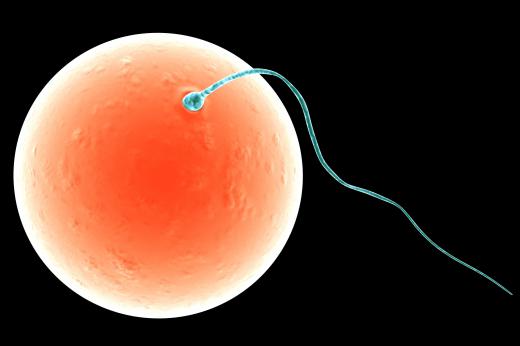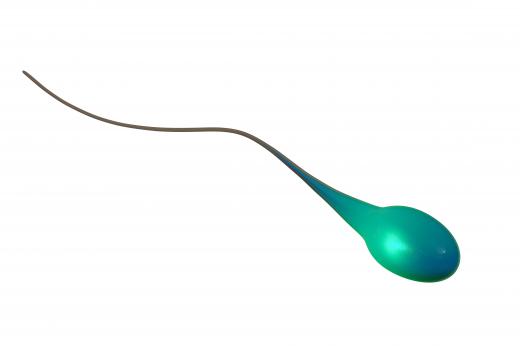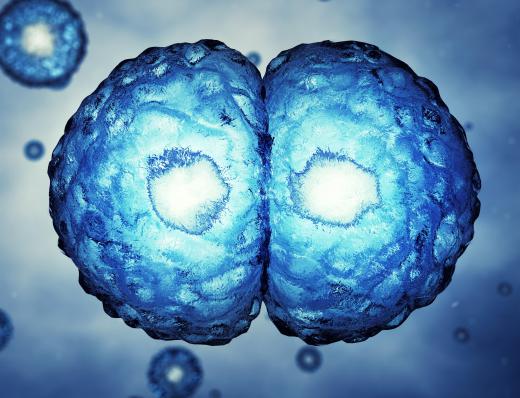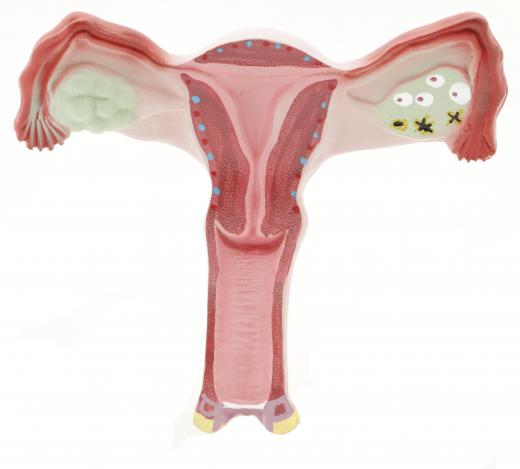What is Fertilization?
Fertilization is the process in which an egg and a sperm cell come together to form a zygote, beginning the series of events that can result in pregnancy. In mammals, including in human beings, eggs are released from the female ovary, and sperm from the male penis. Fertilization typically happens through sexual intercourse, but scientific advances have paved the way for in vitro techniques, which are carried out in a laboratory.
Mammalian Versus Non-Mammalian Species

Many animal species experience fertilization in a similar way, but the events leading up to the event can differ markedly. In mammals, it is preceded by sexual intercourse, but in other species this is not always the case. Some non-mammalian species, such as birds and some reptiles, do engage in a form of intercourse. The males of these species do not have a penis, but instead have an opening called a cloaca, which is pressed against the female cloaca to allow for the transfer of sperm. Eggs are fertilized inside the female, so that the protective shell can form around each zygote before it is laid.

Other reptile species, including amphibians, have different ways of ensuring that egg and sperm come into contact with one another. In frogs, for example, the male typically mounts the female and releases sperm onto eggs as they are laid. Many species of fish reproduce in a similar fashion. For others, the process can occur without any physical contact, with males swimming past and fertilizing eggs previously deposited by a female.
Ovulation

In mammals, the process by which an ovary releases an egg is called ovulation. This event occurs about 14 days after the start of a woman’s menstrual period, which is also considered the first day of the menstrual cycle. Ovulation, therefore, occurs at approximately the midpoint of the cycle. After an egg has been released, it travels through the fallopian tube, where it remains for around one day. If fertilization does not occur during this time, the egg breaks down.
Sperm Production

Sperm cells are produced in vast numbers in the male testes, and approximately 300 million are expelled into the vagina during ejaculation. Of these, around 200 reach the egg, and typically only one will fertilize it. This ensures that the resulting zygote has the correct combination of genetic material. If two sperm fertilize a single egg, the zygote fails to divide properly and does not develop further.
Events in Fertilization

Once they penetrate the cervix and enter the uterus, sperm are able to remain for up to five days before dying off. These sperm use a phenomenon called chemotaxis to locate the egg, if one is present. This refers to the way in which the concentration of a given chemical in the environment can change according to location. In this case, sperm that get close to the fallopian tubes are able to locate the egg by following a trail of hormones that the egg releases.
The first sperm to reach the egg binds with molecules on its surface, and this interaction causes chemical changes in the membrane of the egg. These changes help the sperm move through the egg’s membrane, and also prevent any additional sperm from binding. Once the sperm is inside the egg, its own membrane is dissolved, allowing the contents of the two to mix. When the genetic material of the egg and sperm come together, the new zygote begins to divide. Fertilization is considered complete once the genetic material has combined.
The success of fertilization depends on several factors, including the timing of sexual intercourse relative to the woman’s menstrual cycle and the reproductive health of both the woman and the man involved in the process. Various different conditions can reduce the fertility of either party. In men, a low sperm count, or sperm with low mobility, can reduce the chance that a sperm will reach an egg. In women, a condition such as endometriosis, a disease of the uterine lining, can prevent implantation from occurring.
Implantation in the Uterus
Fertilization typically occurs in one of the fallopian tubes, after which the egg travels to the uterus over a period of around three days. Once in the uterus, the zygote implants in the endometrial lining to continue development. On rare occasions, a zygote fails to move to the uterus, and instead implants in the wall of the fallopian tube. This results in an ectopic pregnancy, an event that ultimately prevents fetal development and can endanger the health of the pregnant woman.
Reproductive Assistance
For people who are unable to conceive via sexual intercourse, modern technology provides ways to bypass some of the biological requirements of fertilization. One such method is intrauterine insemination, which ensures that the egg and sperm are able to make contact. In this process, a woman is given medications that promote the release of multiple eggs during ovulation. When ovulation occurs, prepared sperm cells provided by her male partner are introduced directly into her uterus.
In vitro fertilization involves similar techniques of increasing a woman’s egg production with medication. Sperm is harvested in the same manner as before, but instead of introducing sperm into the uterus, the woman’s eggs are retrieved from her fallopian tubes and mixed with sperm in a culture dish. After several days, fertilized eggs are selected and implanted into the woman’s uterus. Because multiple embryos are usually implanted to increase the chances of pregnancy, this method often results in multiple births.
AS FEATURED ON:
AS FEATURED ON:















Discussion Comments
I take birth control pills to prevent fertilization. I don't want kids, and I feel fairly secure with this method of birth control. It keeps my egg from ever being released, so that is a pretty safe method.
As an added bonus, my periods are so much lighter and less painful than they were before I started the pill. Also, I always know when my cycle will start, so I don't have any surprises.
It has also helped improve my complexion. Birth control pills are good at clearing up acne.
The fertilization process seems so simple, yet it can be so hard for people who are trying to have a baby. It seems that the more you want it, the more it escapes you!
My sister and her husband desperately wanted a baby. They tracked her ovulation and did everything to enhance the chances of her getting pregnant, but it took over a year for fertilization to happen.
@Kristee – Cost is what holds the majority of couples back. The price depends on many things, like your age and your overall health.
However, you can expect to pay around $15,000, more or less. This is like buying a new vehicle, and when you take into account all the medical bills you will incur in addition to this if you do get pregnant, as well as the cost of diapers and medical care for your baby, it is more like buying a new house!
If at all possible, it is best to conceive naturally. That way, at least you won't be in debt before your baby is even born!
My husband and I are considering visiting a fertility clinic. I am 34, and if we are ever going to have kids, the time is now.
The only thing holding us back is the cost. I've heard that in vitro fertilization is very expensive, but I don't know the specifics. Can anyone tell me approximately how much we can expect to spend on this?
@MrsWinslow - In theory, I think they are the same, but in practice, people seem to use them slightly differently. People seem to use "conception" to refer to the act of intercourse that made the baby. ("I was conceived on New Years' Eve"; "I know when we conceived Mikey because we only had sex once.")
But fertilization might take place a few days later than the actual sex. How long afterwards it can happen depends on the combined fertility of the man and woman. Cervical fluid has to be present to keep sperm alive until the egg appears, and some women have better quality cervical fluid for more days than others. And some men have hardier sperm.
Good luck with your baby dreams!
Is human fertilization the same thing as conception? I know that's a dumb question but I've been trying to conceive and I'm just not totally sure when I hear about "conception" if they mean the meeting of sperm and egg or something slightly different.
Post your comments